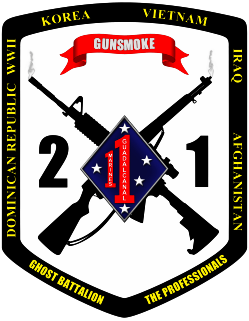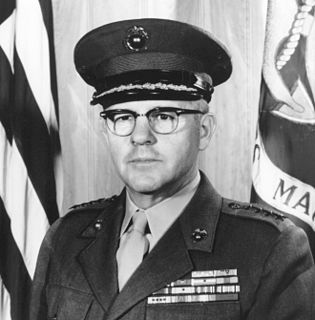
2nd Battalion, 1st Marines (2/1) is an infantry battalion in the United States Marine Corps based out of Camp Horno on Marine Corps Base Camp Pendleton, California. Nicknamed "The Professionals," the battalion consists of approximately 1,200 Marines and Sailors. Normally they fall under the command of 1st Marine Regiment and the 1st Marine Division.

David Monroe Shoup was a general of the United States Marine Corps who was awarded the Medal of Honor in World War II, served as the 22nd Commandant of the Marine Corps, and, after retiring, became one of the most prominent critics of the Vietnam War.

The 26th Marine Regiment is an inactivated infantry regiment of the United States Marine Corps. The 26th Marines were activated in 1944 and fought in the Battle of Iwo Jima during World War II and were activated again on March 1, 1966, and fought in the Battle of Khe Sanh during the Vietnam War.

Military simulations, also known informally as war games, are simulations in which theories of warfare can be tested and refined without the need for actual hostilities. Many professional analysts object to the term wargames as this is generally taken to be referring to the civilian hobby, thus the preference for the term simulation.

In the Vietnam War, after the assassinations of Ngo Dinh Diem and John F. Kennedy in late 1963 and the Gulf of Tonkin incident in 1964 and the continuing political instability in the South, the United States made a policy commitment to begin joint warfare in South Vietnam, a period of gradual escalation and Americanization, involving the commitment of large-scale combat forces from the United States and allied countries. It was no longer assumed the Republic of Vietnam could create a desirable situation without major external assistance. This phase of the war lasted until the election of Richard Nixon, and the change of U.S. policy to Vietnamization, or giving the main combat role back to the South Vietnamese military.

In 1965, the United States rapidly increased its military forces in South Vietnam, prompted by the realization that the South Vietnamese government was losing the Vietnam War as the communist-dominated Viet Cong gained influence over much of the population in rural areas of the country. North Vietnam also rapidly increased its infiltration of men and supplies to combat South Vietnam and the U.S.. The objective of the U.S. and South Vietnam was to prevent a communist take-over. North Vietnam and the insurgent Viet Cong sought to unite the two sections of the country.

William Conrad Gibbons was an American historian and foreign policy expert. Gibbons died at age 88.
The Sigma war games were a series of classified high level war games played in the Pentagon during the 1960s to strategize the conduct of the burgeoning Vietnam War. The games were designed to replicate then-current conditions in Indochina, with an aim toward predicting future events in the region. In almost all runs, the outcome was either a communist win, or a stalemate that led to protests in the US.
Sigma I-63 was one of the series of Sigma war games. These were a series of classified high level war games played in the Pentagon during the 1960s to strategize the conduct of the burgeoning Vietnam War. These simulations were designed to replicate then-current conditions in Indochina, with an aim toward predicting future foreign affairs events. They were staffed with high-ranking officials standing in to represent both domestic and foreign characters; stand-ins were chosen for their expertise concerning those they were called upon to represent. The games were supervised by a Control appointed to oversee both sides. The opposing Blue and Red Teams customary in war games were designated the friendly and enemy forces as was usual; however, several smaller teams were sometimes subsumed under Red and Blue Teams. Over the course of the games, the Red Team at times contained the Yellow Team for the People's Republic of China, the Brown Team for the Democratic Republic of Vietnam, the Black Team for the Viet Cong, and Green for the USSR.
The Sigma I-66 war game was one of a series of classified high level war games played in The Pentagon during the 1960s to strategize the conduct of the burgeoning Vietnam War. Sigma I-66 was based on the unrealistic scenario of a famine-stricken and militarily diminished North Vietnam agreeing to de-escalate its war efforts. It ended with a hypothetical force of 100,000 Viet Cong still in South Vietnam.
The Sigma II-66 war game was one of a series of classified high level war games played in the Pentagon during the 1960s to strategize the conduct of the burgeoning Vietnam War. The games were designed to replicate then-current conditions in Indochina, with an aim toward predicting future foreign affairs events. They were staffed with high ranking officials standing in to represent both domestic and foreign characters; stand-ins were chosen for their expertise concerning those they were called upon to represent. The games were supervised by a Control appointed to oversee both sides. The opposing Blue and Red Teams customary in war games were designated the friendly and enemy forces as was usual; however, several smaller teams were sometimes subsumed under Red and Blue Teams. Over the course of the games, the Red Team at times contained the Yellow Team for the People's Republic of China, the Brown Team for the Democratic Republic of Vietnam, the Black Team for the Viet Cong, and Green for the USSR.
The Sigma I-62 war game, played in February 1962, was the first of a series of classified high level war games played in the Pentagon during the 1960s to strategize the conduct of the burgeoning Vietnam War. These simulations were designed to replicate then-current conditions in Indochina, with an aim toward predicting future foreign affairs events. The conclusion drawn from Sigma I-62 was that American intervention in Vietnam would be unsuccessful.
The Sigma I-64 war game, one of the Sigma war games, was played from 6 to 9 April 1964. Its purpose was to test scenarios of escalation of warfare in Vietnam. After rigorous research into information needed to form a scenario, a simulation took place, with knowledgeable officials playing out the roles of actual government decision makers. Participants were drawn from the State Department, Department of Defense, the Central Intelligence Agency, and the Joint Chiefs of Staff. In Sigma I-64, the scenarios to be examined were the burgeoning Viet Cong insurgency in Vietnam, and the possible use of U.S. air power against it.
The Sigma II-64 war game was one of a series of classified high level war games played in The Pentagon during the 1960s to strategize the conduct of the burgeoning Vietnam War. The games were designed to replicate then-current conditions in Indochina, with an aim toward predicting future foreign affairs events. They were staffed with high-ranking officials standing in to represent both domestic and foreign characters; stand-ins were chosen for their expertise concerning those they were called upon to represent. The games were supervised by a Control appointed to oversee both sides. The opposing Blue and Red Teams customary in war games were designated the friendly and enemy forces as was usual; however, several smaller teams were sometimes subsumed under Red and Blue Teams. Over the course of the games, the Red Team at times contained the Yellow Team for the People's Republic of China, the Brown Team for the Democratic Republic of Vietnam, the Black Team for the Viet Cong, and Green for the USSR.
The Sigma II-65 war game was one of a series of classified high level war games played in the Pentagon during the 1960s to strategize the conduct of the burgeoning Vietnam War. It was held between 26 July and 5 August 1965. The games were designed to replicate then-current conditions in Indochina, with an aim toward predicting future foreign affairs events. They were staffed with high ranking officials standing in to represent both domestic and foreign characters; stand-ins were chosen for their expertise concerning those they were called upon to represent. The games were supervised by a Control appointed to oversee both sides. The opposing Blue and Red Teams customary in war games were designated the friendly and enemy forces as was usual; however, several smaller teams were sometimes subsumed under Red and Blue Teams. Over the course of the games, the Red Team at times contained the Yellow Team for the People's Republic of China, the Brown Team for the Democratic Republic of Vietnam, the Black Team for the Viet Cong, and Green for the USSR.
The Sigma I-67 and II-67 War Games were two of a series of classified high level war games played in the Pentagon during the 1960s to strategize the conduct of the burgeoning Vietnam War. The games were designed to replicate then-current conditions in Indochina, with an aim toward predicting future foreign affairs events. They were staffed with high-ranking officials standing in to represent both domestic and foreign characters; stand-ins were chosen for their expertise concerning those they were called upon to represent. The games were supervised by a Control appointed to oversee both sides. The opposing Blue and Red Teams customary in war games were designated the friendly and enemy forces as was usual; however, several smaller teams were sometimes subsumed under Red and Blue Teams. Over the course of the games, the Red Team at times contained the Yellow Team for the People's Republic of China, the Brown Team for the Democratic Republic of Vietnam, the Black Team for the Viet Cong, and Green for the USSR.
Hill 724 is a former U.S. Marine Corps (USMC) base near the summit of the Hải Vân Pass north of Da Nang in central Vietnam.











